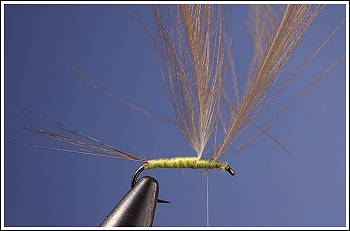|

Hackling CDC
By Leon Links A few weeks ago Martin Westbeek published his very nice
Yellow CDC Mayday here in Rackelhanen web magazine. In his introduction to the fly he told about the problems he meets with when winding a CDC hackle This strongly reminds me of the story in Gerhard Laible's first article
"Die kombinierte Elementbehechelung" in German magazine
"Der Fliegenfischer" (number 61, 1985. p.28-29). Here Gerhard reported - like Martin - about his difficulties with the CDC hackle. Obtaining a satisfying result was almost impossible due the thick stem. Good CDC feathers were hard to get at the time.
After a lot of experiments Gerhard developed the "Elementbehechelung" a clever but time consuming method. This is the same technique Martin describes and shows clearly in his step-by-step instruction for the Yellow CDC Mayday. In the twenty years I work with CDC now, I've seen many people working with the Elementbehechelung method. Martin names it the pull-and-clip technique.
Nice bonus of this method is that it is very appropriate for combining various materials. If I remember well Gerhard tied for instance CDC and partridge together.
That's why he named it
"Kombinierte Elementbehechelung". This technique was very important for CDC tying but certainly not because it should improve the traditional Swiss and French CDC hackling as practised from the 1920s in the Jura. The
"Elementbehechelung" is complicated and - Martin is right - time consuming.
So, what than was the meaning of Gerhard's finding? The answer is simple: it set Gerhard up to further experiments using CDC without stem! In the years thereafter Gerhard published at least fifteen Vom Cul de Canard articles containing numerous ideas for working with CDC in a dubbing loop and paper clamp.
Now back to the problems with CDC hackling of Gerhard, Martin and many other tiers (including myself at the beginning). In my opinion there are two causes why hackling CDC feathers can be so frustrating. At first there are the feathers. It is impossible to wind a nice CDC hackle, especially on 17 size hooks (and smaller!) when you don't have the right material. Compare it to hackling with cock hackles. Working with Hoffman feathers for instance is much easier then with the ones from an India skin. Top quality CDC feathers (for winding) are not large but they are dense and they have thin stems. Large feathers are appropriate for different techniques. The top parts of large feathers can be ok for winding, but most of the time they are not dense enough.
The second cause is using the wrong technique. I only succeeded obtaining satisfying CDC hackles after a long time of trial and error. Essential is positioning the feather and leaving enough space for the windings, and in my opinion it is better to work with two or three feathers. In the next step-by step instruction I'll show you how I work. Realize I'm working on an 18 hook!
Light greenish CDC Dun
Hook: Tiemco 100 size 18
Thread: Danville's Spiderweb
Tail: Grey cock fibres
Body: Light green floss
Hackle: Two small CDC feathers
Instruction:
1. Run a foundation of thread down the shank and tie in a bunch of cock hackle fibres for the tail.

2. Select a small dense CDC fibre ( appr. 2 cm).

3. Tie it in 1 mm behind the eye of the hook on top of the shank, concave side up.

4. Tie in the second feather 1 mm behind the first feather, on top of the shank.

5. Tie in the floss.

6. Form a conical abdomen, wind through the feathers and tie off just behind the eye.

7. Carefully wind the first feather, secure with enough thread windings (!) and clip off.

8. Time for the second feather. Tie off and whip finish.

9. Pull DC fibres over the eye and clip to desired length.

10. Frontal view.

11. If you like it better, clip off the lowest fibres for in the surface fly.

12. Completed fly

©
Leon Links 2005 |